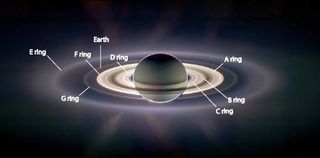Saturn's Rings: Composition, Characteristics & Creation
Saturn, the sixth planet from the sun, is one of the most easily identified targets for astronomers, largely due to its large and distinct ring system. The rings of Saturn have fascinated stargazers for centuries, ever since telescopes were first pointed toward the sky.
When Galileo Galilei first observed Saturn in 1610, he thought that the rings were enormous moons, one positioned on each side of the planet. Over several years of observations, he noted that the rings changed shape and even disappeared, as they changed their inclination with respect to Earth.

We now know that Galileo was observing a "ring plane crossing." Saturn's equator is tilted relative to its orbit around the sun by 27 degrees – similar to Earth's 23-degree tilt. As Saturn circles the sun, first one hemisphere and then the other is tilted sunward. The tilt causes seasons, just as it does on Earth, and when Saturn reaches equinox, its equator and ring plane are directly in line with the sun. Sunlight hits the rings edge-on, and the fine line of the rings is difficult to detect. The rings are wide — 170,000 miles across (273,600 km) — but only about 30 feet (10 meters) thick.
In 1655, astronomer Christaan Huygens suggested that the strange bodies were solid, inclined rings, and in 1660 another astronomer suggested that the rings were made up of small satellites, an insight that wasn't confirmed for nearly 200 years.
In modern times, Pioneer 11 passed through the Saturn ring plane in 1979. In the 1980s, Voyager 1 and Voyager 2 glimpsed the planet's ring system.
In 2004, NASA's Cassini-Huygens mission became the first to enter orbit around Saturn, taking detailed observations not only of the planet but of its ring system.

Composition and structure
Saturn's rings are made up of billions of particles ranging from grains of sand to mountain-size chunks. Composed predominantly of water-ice, the rings also draw in rocky meteoroids as they travel through space.
Though Saturn appears surrounded by a single, solid ring when viewed by an amateur astronomer, several divisions exist. The rings are named alphabetically in the order of discovery. Thus the main rings are, from farthest from the planet to closest, A, B and C. A gap 2,920 miles wide (4,700 kilometers), known as the Cassini Division, separates the A and B rings.
Other, fainter rings have been discovered as telescope technology has improved. Voyager 1 detected the innermost D ring in 1980. The F ring lies just outside of the A ring, while the G and E ring lay even farther out.
The rings themselves contain a number of gaps and structures. Some are created by Saturn's many small moons, while others continue to puzzle to astronomers.
Saturn is not the only planet in the solar system to have rings — Jupiter, Uranus and Neptune also contain faint ring systems — but with its satellites spanning three-quarters of the Earth-moon distance (175,000 miles or 282,000 km), it is by far the largest and most visible.
Formation theories
Several hypotheses exist as to the how Saturn's rings were formed. Some scientists think that passing comets or asteroids were snagged by the planet's gravity and broken up before reaching it.
Another possibility is that the rings were once large moons that spiraled into the planet. Saturn has at least 62 moons. Only one (Titan) is large; the rest are small bodies. Only 13 of the moons are larger than 30 miles (50 km). The gravity of these moons affects the structure of Saturn's rings, but also offer insight into possible formation methods. If the icy outer layers were stripped away, leaving the core to crash into Saturn, the result would be rings dominated by nearly pure water-ice. [PHOTOS: The Rings and Moons of Saturn]
Join our Space Forums to keep talking space on the latest missions, night sky and more! And if you have a news tip, correction or comment, let us know at: community@space.com.
Get the Space.com Newsletter
Breaking space news, the latest updates on rocket launches, skywatching events and more!

Nola Taylor Tillman is a contributing writer for Space.com. She loves all things space and astronomy-related, and enjoys the opportunity to learn more. She has a Bachelor’s degree in English and Astrophysics from Agnes Scott college and served as an intern at Sky & Telescope magazine. In her free time, she homeschools her four children. Follow her on Twitter at @NolaTRedd
